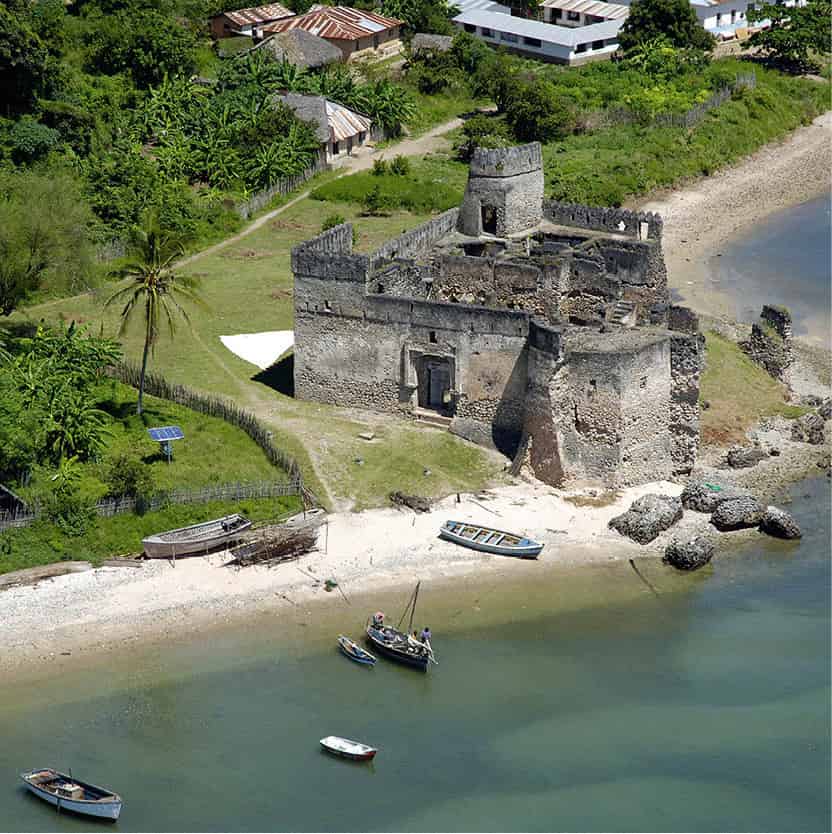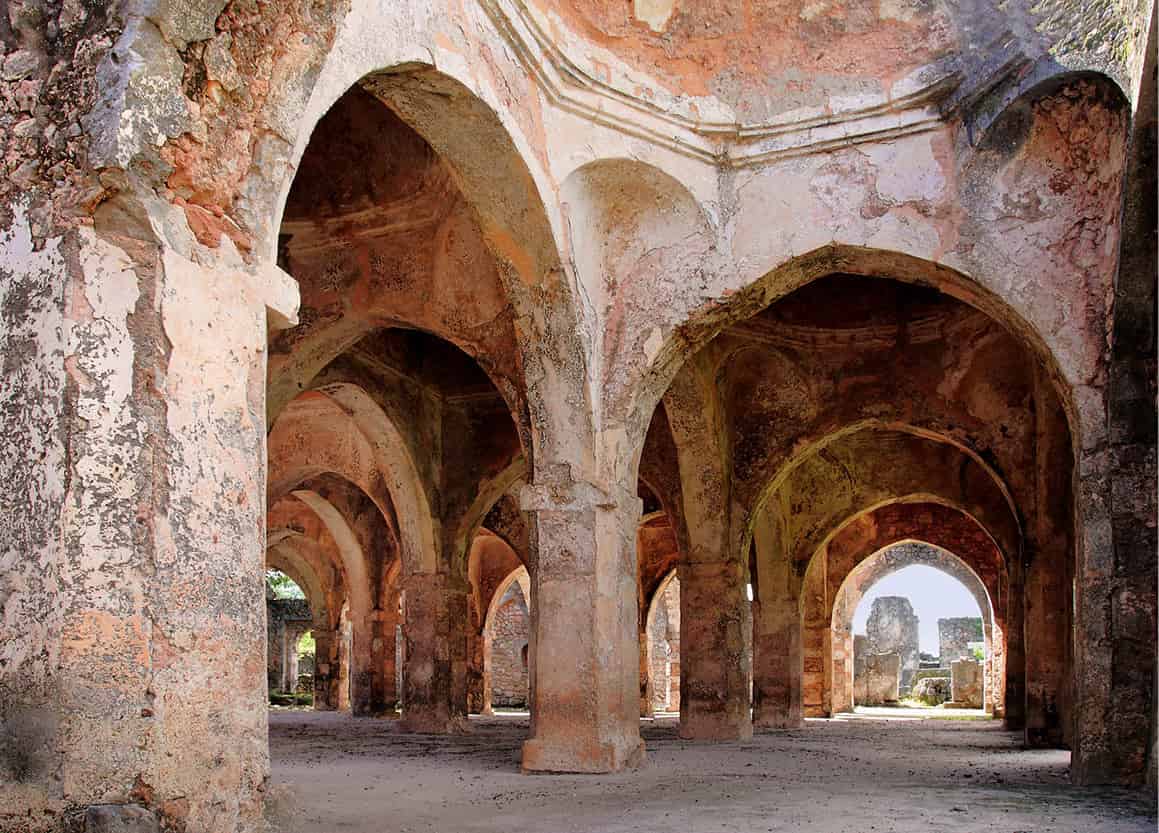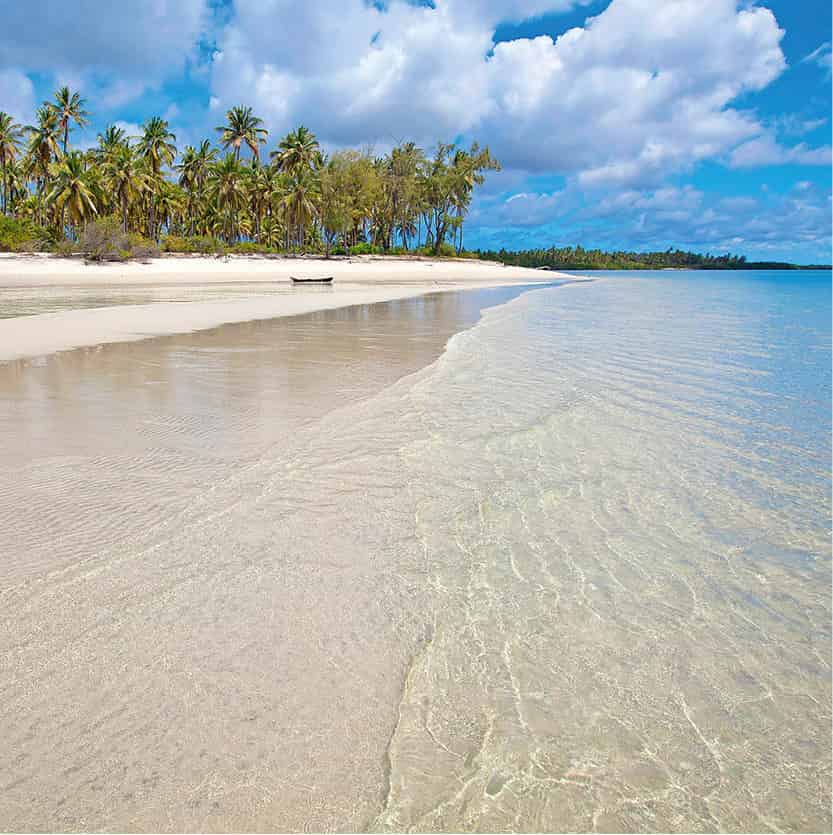
The design of the Swahili dhows is little changed since ancient times.
Ariadne Van Zandbergen/Apa Publications
With its sticky tropical ambience and generous quota of postcard-perfect beaches and atmospherically time-worn ports, the 600km (370-mile) coastline that stretches from Dar es Salaam south to the Mozambican border shares most of the elements that have made Zanzibar such a popular post-safari chill-out destination. What it lacks, however, is a tourist infrastructure comparable to Zanzibar’s.

Aerial view of the fort on Kilwa Kisiwani.
Photoshot
True, the main coastal road has improved greatly in recent years, but many side roads are bumpy dustbowls that transform into impassable quagmires at the height of the rains. What’s more, aside from Mafia Island (which has few travel links to the facing mainland) there are just a handful of hotels along the entire south coast that loosely conform to the description ‘idyllic beach resort’. Indeed – while certain areas are beginning to open up – as a whole, the region is not much better suited to package holidays than it would be to dedicated ski parties!
Nevertheless, this remote part of Tanzania has much to recommend it to travellers seeking genuine insight into Swahili culture past and present. It is not merely that the area’s assortment of ruined and living settlements provides a cross-section of coastal trade and history over the past millennium. There is, too, a pervasive aura of cultural continuity hanging over this forgotten corner of Tanzania, the feeling that while its front foot stretches gamely towards the future, the other one remains firmly planted at the cusp of the 19th and 20th centuries.
Kilwa
The south coast has not always been the backwater it is today. Exhibit one for the defence, and unquestionably the region’s one ‘must-see’ attraction, is the extensive, ruined medieval port of Kilwa, described in 1331 by the insatiable Arab sightseer Ibn Buttata as ‘one of the most beautiful and well-constructed towns in the world’. For three bountiful centuries before the arrival of the Portuguese, Kilwa was the greatest trade emporium on the coast south of Mogadishu, the site of the first coin mint in sub-equatorial Africa, as well as of a clutch of buildings that stand at the pinnacle of Swahili architectural achievement. Every year, at the peak of the monsoon winds, the island’s small harbour bustled with commercial activity, as fleets of ocean-going dhows sailed from the sultanates of Arabia and great empires of Asia to purchase or barter for Kilwa’s legendary stockpiles of gold, sourced from Great Zimbabwe.
The ruins of Kilwa lie on Kilwa Kisiwani 1 [map] (Kilwa on the Island), divided by a narrow estuarine channel from the rather nondescript mainland port of Kilwa Masoko 2 [map] (Kilwa Market). Connected to Dar es Salaam by occasional flights and an adequate 300km (180-mile) road, Kilwa Masoko is dotted with a few comfortable (through far from luxurious) beach hotels and numerous guesthouses. The opening of a local tourist information office on the market square in 2015 is the most visible sign that tourism is being taken seriously by local authorities, who are making great efforts to promote the district’s cultural heritage and natural sites.
For tickets to visit the island, visit the Department of Antiquities office in the administrative buildings. The dhow trip across the channel can take anything from 10 to 45 minutes, depending on the prevailing winds and currents; allocate at least half a day for the expedition.
The shoreward side of Kilwa Kisiwani is dominated by an imposing, partially collapsed fort known locally as the Gereza, built around 1800 during a brief Omani occupation of the island, and entered via imposing wooden Zanzibar doors. A short footpath leads uphill past the fort, through a cheerful fishing village, to the abandoned medieval trading centre, studded by semi-collapsed mosques and palaces, as well as the ornately carved tombs of a succession of powerful sultans.

Interior of the 14th-century Great Mosque, Kilwa Kisiwani.
Dreamstime
The singularly lovely Great Mosque is the most inspired Swahili building of the medieval period. Its exquisite domed roof, supported by bays of precisely hewn arches, remains largely intact a full seven centuries after it was constructed. Ten minutes’ walk east of the main ruins, on a rise overlooking the beach, stands the Husuni Kubwa, the isolated and ostentatious palace – complete with sunken audience court and swimming pool – where the Sultan of Kilwa played host to Ibn Buttata in 1311.
Kilwa Kivinje
Kilwa’s decline, precipitated by a Portuguese naval bombardment in 1505, was sealed 50 years later when the cannibalistic Zimba raided the island and corralled its 3,000 residents to devour at their leisure. The area enjoyed a revival in the early 19th century, with the arrival of a group of Omani settlers who stayed briefly on the island before founding the mainland port of Kilwa Kivinje 3 [map] (Kilwa beneath the Casuarina Trees); this was the terminus of the slave caravan route to the Lake Nyasa hinterland.
During the 20th century, Kilwa Kivinje degenerated into a fascinating time warp of alleys lined with decaying balconied Omani mansions, leading to a mangrove-lined waterfront dominated by the hulk of a disused German boma (colonial office). Spend time in Kilwa Kivinje, and its fading architectural grandeur starts to feels curiously anomalous – as if the Omani ghost town had been superimposed on a randomly selected overgrown fishing village. Decidedly strange but satisfyingly authentic, Kilwa Kivinje will reward any traveller who wishes to spend a few days absorbing the slow pace of a traditional Swahili settlement – ruled today, as in medieval times, by the vagaries of the tides and the winds.
Lindi
Some 230km (140 miles) south of Kilwa, Lindi 4 [map] is the most substantial settlement on the coast between Dar es Salaam and Mtwara. Lindi was founded on the north bank of the Lukuledi River Estuary at about the same time as Kilwa Kivinje, but it was not an especially significant port during the Omani era, and the only major structure dating from this time is a tall stone jail near the seafront. The grid-like layout and architectural style of the run-down town centre speak of a degree of prosperity during the early colonial period, evidently curtailed by the emergence of Mtwara as the main regional harbour in the 1950s.
Immediately north of the centre, a curving, sandy beach runs into a busy, traditional dhow harbour. Regular motorised ferries run across the estuary to the fishing village of Kitunda. Local fishing boats can be rented to explore the estuary upstream or to visit the fruit-bat colony on the offshore Bat Island. Further afield, some 30km (19 miles) east of Lindi and accessible by dirt road, the Litipo Forest Reserve shelters a rich variety of birds of the coastal forest biome, while a trio of lakes bordering the reserve harbour a few hippos and are sporadically visited by elephants.
Mtwara and surrounds
Linked to Lindi by a blissfully smooth stretch of tarmac, Mtwara 5 [map] is a substantial harbour town of 135,000 residents, situated 20km (12 miles) north of the Mozambique border. It was founded in 1947, when its deep-water harbour was developed to service the disastrously misconceived post-war Groundnut Scheme (for more information, click here). As a consequence, Mtwara has never really grown to flesh out its ambitious skeleton. The nominal town centre, main market area, residential suburbs and harbour are all divided from each other by open fields. The town is not overly endowed with character, but the lovely beach, friendly atmosphere and adequate facilities ensure that it’s an agreeable place to break your journey.
Fact
The word ‘dhow’ derives from the Portuguese term não, used for any small seafaring vessel. Several designs of dhow are used on the Swahili coast, including the 20-metre (26ft) long jahazi, with a capacity of 100 passengers, the smaller but similar mashua, and the distinctive ngalawa, a 5- to 6-metre (16 to 20ft) long dugout with narrow outriggers.
Straddling the Lindi road 10km (6 miles) north of Mtwara, the tiny village of Mikindani 6 [map] is where David Livingstone set off on his final expedition into the African interior. A plaque commemorating Livingstone’s ‘reputed dwelling place’ is nailed to the wall of a balconied two-storey house which, while rather picturesque, has several architectural quirks suggesting it was constructed nearly a century after the explorer’s death. However, Mikindani does have several genuinely interesting German- and Omani-era relics, most impressively the fortified 19th-century German Boma, immaculately restored to its whitewashed pomp by the British charity Trade Aid in 1998, and now a hotel.
Committed to opening up the far southeast to all levels of tourism, Trade Aid (www.tradeaiduk.org) can also arrange trips to (or advise independent travellers about) several obscure but rewarding local attractions, including the forested Rondo Plateau, the superb Msimbati Beach, the Lukwika-Lumesule Game Reserve and crocodile-infested Lake Chidya.
Inland of Mtwara, the Makonde Plateau 7 [map] is home to the most celebrated traditional sculptors in East Africa. The main town of the Makonde is Masasi, situated at the base of the plateau among tall granite outcrops reminiscent of parts of Zimbabwe. The breezy highland town of Newala is distinguished by a stirring sweeping view across the Ruvuma River. It is also the last – or first – Tanzanian town passed through by travellers crossing to or from Mozambique via the Unity Bridge, which spans the Ruvuma River and opened in 2010.
Makonde carvings
The Makonde, whose homeland straddles the eastern border of Mozambique and Tanzania, have a matrilineal society unusual for this part of Africa. They are best known for their carvings, which are traditionally sculpted by men only, and relate to a complex ancestral cult of womanhood.
Makonde sculptures achieved renown in the 1950s after a carving workshop was founded in Dar es Salaam. The genre has expanded to include complex sculptures embracing several human figures and symbolising abstract concepts such as Ujamaa (national unity) and good and evil.
In Dar es Salaam, which is now the main centre of commercial carving, outstanding works sell for high prices to collectors. It is harder to visit traditional carvers on the Makonde Plateau in situ without good local contacts.

Untouched nature at Mafia Island.
Bigstock
Linked to Dar es Salaam by regular flights, Mafia is more realistically viewed as a stand-alone upmarket destination than as an extension of the south coast’s rough-and-ready travel circuit. The archipelago, which lies some 20km (12 miles) east of the Rufiji River Delta, is comprised of the 50km (30-mile) long Mafia Island 8 [map] as well as a dozen smaller islets and numerous coral outcrops. The only settlement of any substance is Kilindoni, the main port on Mafia Island, and site of its only airstrip. Elsewhere, the isles are scattered with rustic fishing villages, while a cluster of top-notch and very exclusive lodges lies along Chole Bay, 12km (7 miles) by road from Kilindoni.
Mafia is East Africa’s premier diving, snorkelling and game-fishing venue. The extensive offshore reefs, protected within an 820-sq-km (317-sq-mile) marine park, are comprised of 50 genera of coral and harbour some 400 species of fish. Recommended for their colourful coral formations and kaleidoscopic shoals of small reef fish are the Kinasi Wall and adjoining Chole Wall, near the outlet of Chole Bay, while a 12-metre (40ft) coral pinnacle within the bay is a reliable place for sighting giant cod and moray eels. Further afield, sharks and giant tuna haunt the Dindini North Wall and Forbes Bay on the main barrier reef. Snorkellers are also well catered for: the two larger coral islets in Kinasi Pass host a volume and variety of reef fish that compares favourably with any site in East Africa.

Mafia Island lighthouse.
Bigstock
Nor does Mafia lack historical interest. A short dhow trip across Chole Bay leads to Chole Mjini (Chole Town), where a stand of ancient baobabs houses the disintegrating walls of several 19th-century mansions, built by wealthy Omani merchants who held slave plantations on the main island (then known as Chole Shamba – Chole Farm). Further afield, on Juani Island, the ruined city of Kua was founded at about the same time as Kilwa, and is one of the few medieval ports in East Africa to have been inhabited continuously into the 19th century. Nearby Jipondo Island is an important traditional shipbuilding centre, where dhows are constructed using traditional tools.
